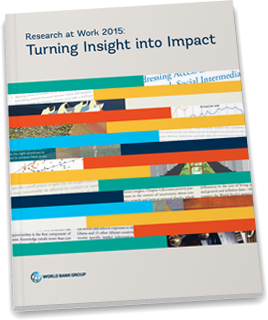 As the World Bank takes stock following its annual Spring Meetings, it’s clear that rigorous and policy-relevant research remains a critical element in achieving the goals of the institution. From informing the Bank’s Twin Goals in our latest Policy Research Report to creating the Findex database that underlies the institution’s commitment to achieving universal financial inclusion, research continues to shape the Bank’s agenda and provide the foundation of evidence-based policy advice sought by its clients. Without the independent scrutiny of research, the conceptual and empirical foundations for policymaking would be weak, “best practices” would be emulated without sufficient evidence, and new fads and fashions would get more attention and traction than they deserve.
As the World Bank takes stock following its annual Spring Meetings, it’s clear that rigorous and policy-relevant research remains a critical element in achieving the goals of the institution. From informing the Bank’s Twin Goals in our latest Policy Research Report to creating the Findex database that underlies the institution’s commitment to achieving universal financial inclusion, research continues to shape the Bank’s agenda and provide the foundation of evidence-based policy advice sought by its clients. Without the independent scrutiny of research, the conceptual and empirical foundations for policymaking would be weak, “best practices” would be emulated without sufficient evidence, and new fads and fashions would get more attention and traction than they deserve.
That’s why I’m pleased to present Research at Work 2015: Turning Insight into Impact, which reports on key outputs, achievements, and results for the World Bank’s Research Department. The publication reviews the full breadth of the Research Department’s activities, which include not only original, cross-cutting research but also the collection of authoritative and timely data, the creation of tools to aid the work of researchers around the world, and close collaboration with the Bank’s Global Practices and Regions through direct support to operations.
And while most readers of Let’s Talk Development will be familiar with the Research Department’s work, here are a few facts from the publication you might not be aware of:
- The World Bank’s Policy Research Working Papers are the most downloaded series on a per paper basis of any major working paper series.[1]
- Journal articles produced by the department receive more citations per paper than nearly any of the top academic institutions in the world—outperforming the University of Chicago, MIT, and Princeton University, among others.
- Academia tends to vastly undersupply research on the World Bank’s client countries. For example, a mere four papers were written on Burundi over a 20-year period. But over 1/3rd of the Bank’s research is on low-income countries, and around 30 percent on lower-middle income countries.
- The Research Department is the source of dozens of the Bank’s data sources, including the Living Standards Measurement Study, multiple databases that monitor and measure the implications of trade protection, the Worldwide Governance Indicators, and the Bank’s own official poverty estimates, among others.
- Researchers spend about 1/3rd of their time each year providing direct support to the World Bank’s Global Practices and Regions. In Fiscal Years 2013 – 2014, they provided nearly 2,000 weeks of support to the World Bank Regions alone.


Join the Conversation